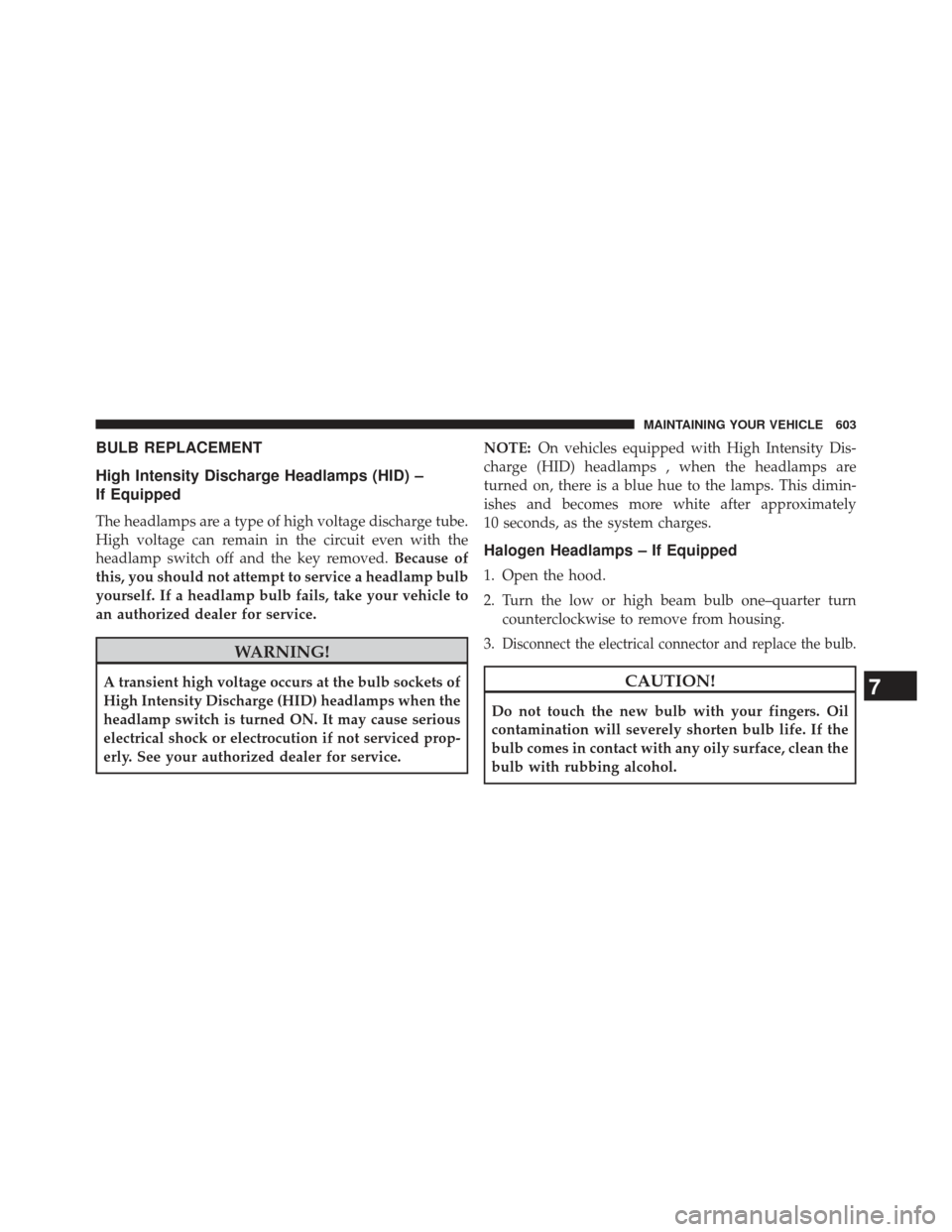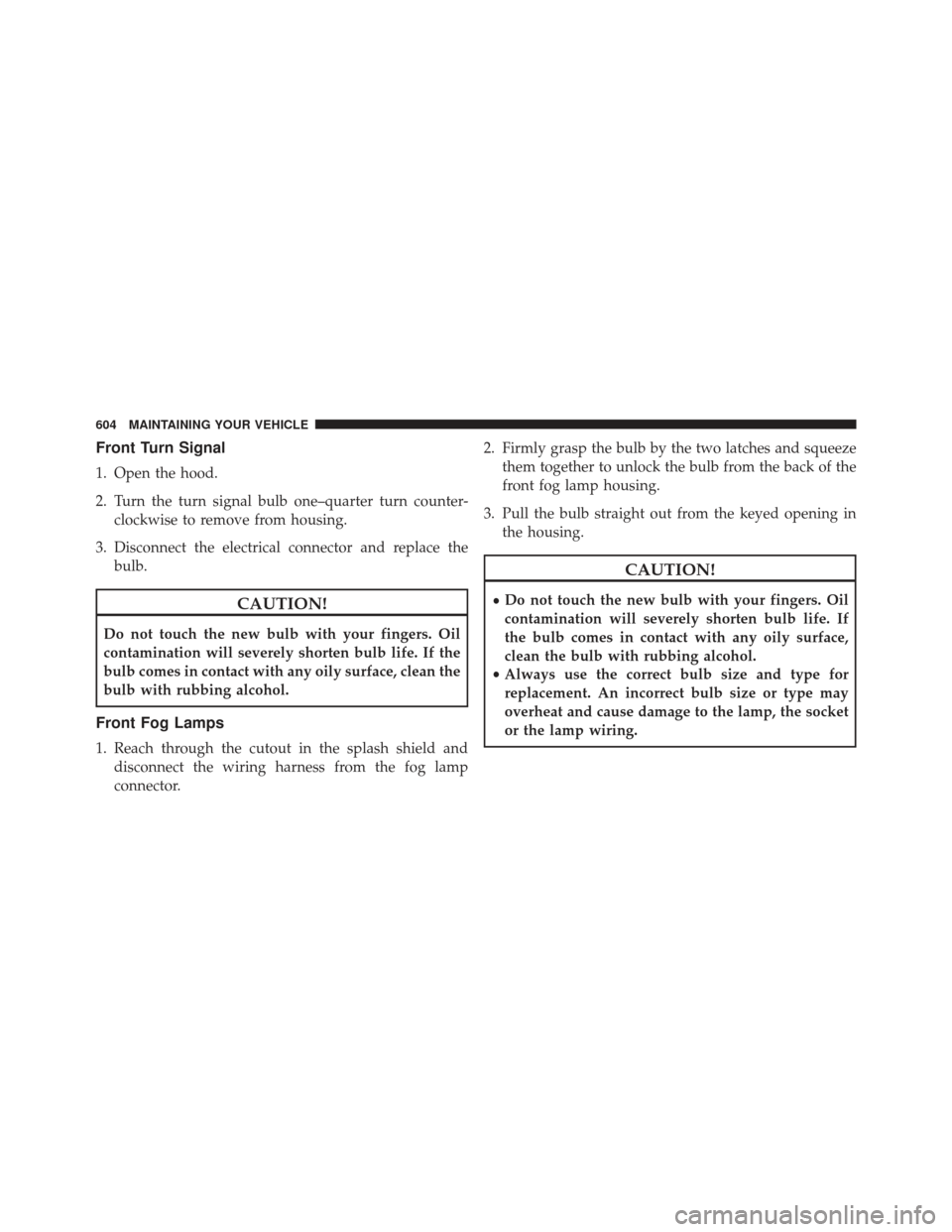Page 560 of 661

▫Transfer Case ....................... .586
▫ Automatic Transmission ................587
▫ Appearance Care And Protection From
Corrosion .......................... .589
� FUSES ............................. .594
▫ Totally Integrated Power Module ..........594
� VEHICLE STORAGE ....................601
� REPLACEMENT BULBS .................602
� BULB REPLACEMENT ..................603
▫ High Intensity Discharge Headlamps (HID) –
If Equipped ........................ .603
▫ Halogen Headlamps – If Equipped .........603▫
Front Turn Signal .....................604
▫ Front Fog Lamps .....................604
▫ Rear Tail, Stop, Turn Signal, And Backup
Lamps ............................ .605
▫ Rear Liftgate Mounted Tail Lamp ..........606
▫
Center High-Mounted Stop Lamp (CHMSL) . . .607
▫ Rear License Lamp ....................607
� FLUID CAPACITIES ....................608
� FLUIDS, LUBRICANTS AND
GENUINE PARTS ..................... .609
▫ Engine ............................ .609
▫ Chassis ............................ .610
558 MAINTAINING YOUR VEHICLE
Page 563 of 661

“Understanding Your Instrument Panel” for further in-
formation. Tighten the fuel filler cap properly and press
the SELECT button to turn off the message. If the
problem continues, the message will appear the next time
the vehicle is started.
A loose, improperly installed, or damaged fuel filler cap
may also turn on the Malfunction Indicator Light (MIL).
EMISSIONS INSPECTION AND MAINTENANCE
PROGRAMS
In some localities, it may be a legal requirement to pass
an inspection of your vehicle’s emissions control system.
Failure to pass could prevent vehicle registration.For states that require an Inspection and Mainte-
nance (I/M), this check verifies the “Malfunction
Indicator Light (MIL)” is functioning and is not
on when the engine is running, and that the OBD II
system is ready for testing. Normally, the OBD II system will be ready. The OBD II
system may
notbe ready if your vehicle was recently
serviced, recently had a dead battery or a battery replace-
ment. If the OBD II system should be determined not
ready for the I/M test, your vehicle may fail the test.
Your vehicle has a simple ignition key-actuated test,
which you can use prior to going to the test station. To
check if your vehicle’s OBD II system is ready, you must
do the following:
1. Turn the ignition switch to the ON position, but do not crank or start the engine.
2. If you crank or start the engine, you will have to start this test over.
3. As soon as you turn the ignition switch to the ON position, you will see the MIL symbol come on as part
of a normal bulb check.
7
MAINTAINING YOUR VEHICLE 561
Page 604 of 661
REPLACEMENT BULBS
Interior Bulbs
Bulb Number
Glove Box Lamp 194
Grab Handle Lamp L002825W5W
Overhead Console Reading Lamps VT4976
Rear Cargo Lamp 214–2
Visor Vanity Lamp V26377
Underpanel Courtesy Lamps 906
Instrument Cluster
(General Illumination) 103
Telltale/Hazard Lamp 74
Exterior Bulbs
Bulb Number
Headlamps (Low Beam) H11
Headlamps (High Beam) 9005
Bulb Number
Headlamps (Low Beam) – High
Intensity Discharge (HID) D1S (Serviced
At Authorized Dealer)
Daytime Running Lamp (DRL) 3157K
Front Fog Lamps PSX24W
Front Side Marker 194
Front Park/Turn Lamp 7444NA
Aux Aperature Backup Lamps 7440 (W21W)
Auxiliary Liftgate Tail Lamps W3W
Liftgate Backup Lamps 921 (W16W)
Rear License Lamps W5W
Rear Turn/Stop/Tail Lamps 3057
NOTE:
Numbers refer to commercial bulb types that can be
purchased from your authorized dealer.
If a bulb needs to be replaced, visit your authorized
dealer or refer to the applicable Service Manual.
602 MAINTAINING YOUR VEHICLE
Page 605 of 661

BULB REPLACEMENT
High Intensity Discharge Headlamps (HID) –
If Equipped
The headlamps are a type of high voltage discharge tube.
High voltage can remain in the circuit even with the
headlamp switch off and the key removed.Because of
this, you should not attempt to service a headlamp bulb
yourself. If a headlamp bulb fails, take your vehicle to
an authorized dealer for service.
WARNING!
A transient high voltage occurs at the bulb sockets of
High Intensity Discharge (HID) headlamps when the
headlamp switch is turned ON. It may cause serious
electrical shock or electrocution if not serviced prop-
erly. See your authorized dealer for service. NOTE:
On vehicles equipped with High Intensity Dis-
charge (HID) headlamps , when the headlamps are
turned on, there is a blue hue to the lamps. This dimin-
ishes and becomes more white after approximately
10 seconds, as the system charges.
Halogen Headlamps – If Equipped
1. Open the hood.
2. Turn the low or high beam bulb one–quarter turn counterclockwise to remove from housing.
3.
Disconnect the electrical connector and replace the bulb.
CAUTION!
Do not touch the new bulb with your fingers. Oil
contamination will severely shorten bulb life. If the
bulb comes in contact with any oily surface, clean the
bulb with rubbing alcohol.
7
MAINTAINING YOUR VEHICLE 603
Page 606 of 661

Front Turn Signal
1. Open the hood.
2. Turn the turn signal bulb one–quarter turn counter-clockwise to remove from housing.
3. Disconnect the electrical connector and replace the bulb.
CAUTION!
Do not touch the new bulb with your fingers. Oil
contamination will severely shorten bulb life. If the
bulb comes in contact with any oily surface, clean the
bulb with rubbing alcohol.
Front Fog Lamps
1. Reach through the cutout in the splash shield anddisconnect the wiring harness from the fog lamp
connector. 2. Firmly grasp the bulb by the two latches and squeeze
them together to unlock the bulb from the back of the
front fog lamp housing.
3. Pull the bulb straight out from the keyed opening in the housing.
CAUTION!
•Do not touch the new bulb with your fingers. Oil
contamination will severely shorten bulb life. If
the bulb comes in contact with any oily surface,
clean the bulb with rubbing alcohol.
• Always use the correct bulb size and type for
replacement. An incorrect bulb size or type may
overheat and cause damage to the lamp, the socket
or the lamp wiring.
604 MAINTAINING YOUR VEHICLE
Page 607 of 661
4. Align the index tabs of the front fog lamp bulb withthe slots in the collar of the bulb opening on the back
of the front fog lamp housing.
5. Insert the bulb into the housing until the index tabs are engaged in the slots of the collar.
6. Firmly and evenly push the bulb straight into the lamp housing until both tabs snap firmly into place and are
fully engaged.
7. Connect the wiring harness to the front fog lamp connector.
Rear Tail, Stop, Turn Signal, And Backup Lamps
1. Raise the liftgate.
2. Remove the two push-pins from the tail lamp housing.
3. Grasp the tail lamp and pull firmly rearward todisengage the lamp from the aperture panel. 4. Twist socket counter clockwise and remove from
lamp.
5. Pull the bulb to remove it from the socket.
6. Replace the bulb, reinstall the socket, and reattach the lamp assembly.7
MAINTAINING YOUR VEHICLE 605
Page 608 of 661
Rear Liftgate Mounted Tail Lamp
1. Raise the liftgate.
2. Use a fiber stick or flat blade screw driver to pry thelower trim from the liftgate.
3. Once lower trim is loose, close the liftgate.
4. Open the flipper glass.
5. Pull up glass seal at bottom of window opening.
6. Remove small trim panel around liftgate glass striker.
7. Close flipper glass and raise the liftgate.
8. Continue removing the trim.
9. Disconnect the two trim panel lights. 10. Tail lamps are now visible. Rotate socket(s) counter
clockwise.
11. Remove/replace bulb(s).
12. Reinstall the socket(s)
13. Reverse process to reinstall the liftgate trim.
Rear Liftgate Tail Lamps
606 MAINTAINING YOUR VEHICLE
Page 609 of 661
Center High-Mounted Stop Lamp (CHMSL)
The center high-mounted stop lamp is an LED assembly.
See your authorized dealer for replacement.
Rear License Lamp
1. Use a screw driver to gently pry against the side of thesnap tab to remove the license lamp lens.
2. Pull bulb from socket.
3. Replace bulb.
4. Reinstall lens.
Center High-Mounted Stop Lamp
7
MAINTAINING YOUR VEHICLE 607